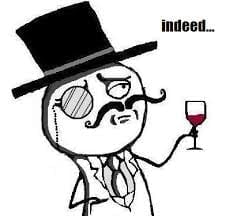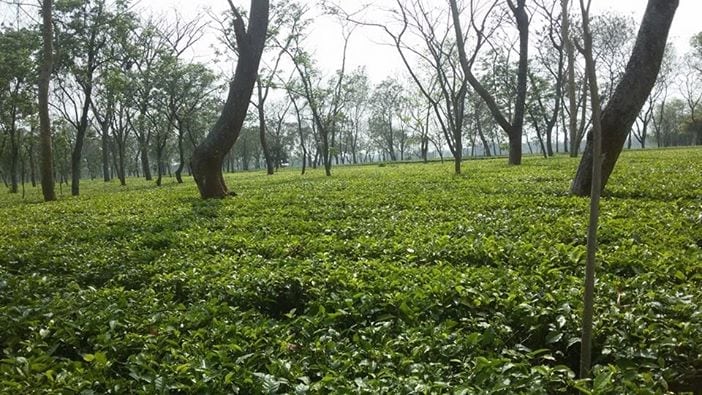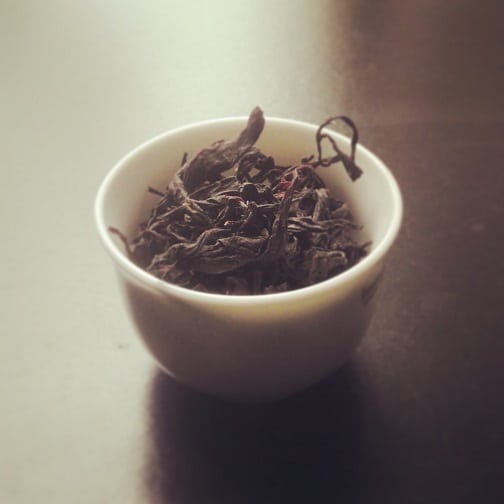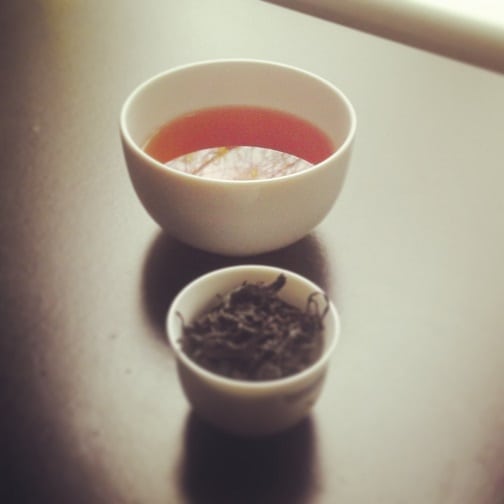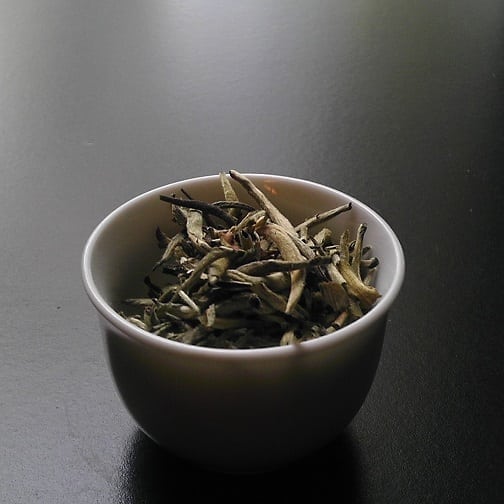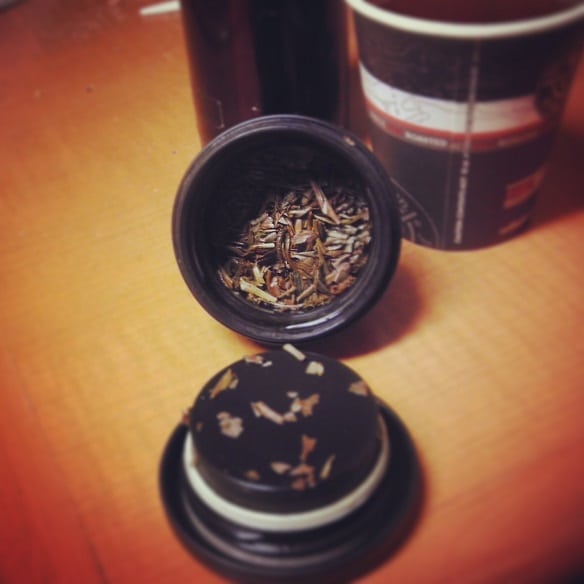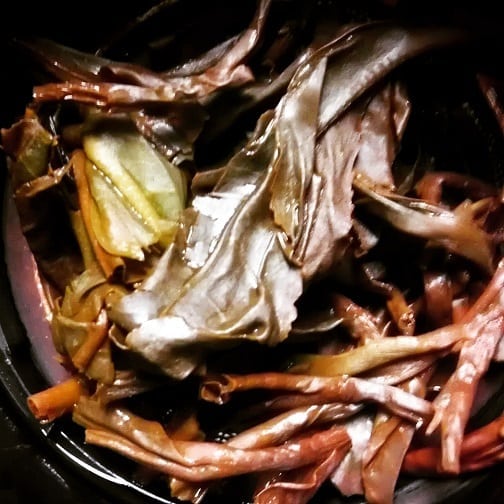To those that have been following the sporadic attempts to give this blog focus, you’ll know I’ve been experimenting with tea fiction. Sometimes with wondrous results…and other times with startling missteps. Train-wreck or not, I figured an exercise on how these yarns developed was worth exploration.
Up until the “Great Vanishing” of September, I had two more entries planned. The process of how they came to fruition was simple. I would first try a rare tea, I would photograph the finished brew, I would jot down taster notes (like from my review days), then I would weave a story around said notes. I only made it halfway through this process on the last five teas I tried. So, what I’m going to do for you – fair reader(s?) – is show those taster notes, and the fictional blurbs I’d come up with around them.
WARNING: The results are…weird.
Tea #1: Lochan Teas Doke Silver Needle

Acquisition: This was one of three samples I received from Mrs. Tea Trade herself, Jackie D. I think she caught wind of my whimpering whenever someone mentioned the Lochan-purveyed, Bihar-located tea estate. She kindly donated this tea and a couple of others for my perusal and odd use.
Taster Notes: The leaves were actually much smaller than I thought they’d be – what with a name like “Silver Needle”. I was expecting plump, down-furred, rolled leaves, but these actually looked like tiny needles. They were comparable to a Risheehat Silver Tip I tried three years ago. There wasn’t much aroma to the leaves, either – spry, somewhat grassy, and mildly lemon-like.
The liquor brewed to a pleasant yellow-green with an aroma of apples and lime. Taste-wise, they more than lived up to their Yinzhen-ish moniker, delivering on the promised melon notes with added dollops of citrus and muscatel grapes. The finish reminded me of a warm Reisling, minus the alcoholic headache.
Fictional Use: This would’ve been the first tea tried by “the other me” (The Lazy Literatus, made manifest as a fictional character), Zombie Robert Fortune, and Thed the Gnome while at a subterranean train station. Formerly Fortune then gets nervous when he sees a literal Grim Reaper sipping tea from the far corner. Soon after, a literal tea trolley pulls up…that is also an actual trolley.
Tea #2: Lochan Teas Doke “Rolling Thunder” Oolong

Acquisition: The second of the three Lochan samples, this was a rare Bihar, India oolong that had me all sorts of excited.
Taster Notes: The visual presentation of the leaves was rife with uniqueness. It looked like an orange pekoe black on first impression but possessed silver-tipped leaves amidst the darker brown ones. The aroma alternated between spice, chocolate and olives. It smelled quite a bit like an oolong I tried from the Phoobsering estate last year.
I gongfu-ed the heck out of this, but didn’t pay attention to brewing times. The liquor alternated between varying shades of amber and bronze throughout the successive infusions. On flavor, it was a surprisingly malty oolong with nutty and fruity notes sprinkled in for good measure. Overall, though, it resembled a more nuanced Nilgiri oolong.
Fictional Use: Once the three companions boarded the tea trolley-that-was-an-actual-trolley, they would’ve been greeted and waited upon a British rabbit in a suit – named Peter. (The security officer of the trolley.) Then their tea needs would’ve been tended to by his spouse, Jackie Rabbit. (Yes, I know, bear with me here.) That is when my alter-ego would’ve encountered another Doke offering – an oolong. All three would’ve found it exquisite, but it would also draw the attention of the Grim Reaper further back in coach.
This would’ve sparked a chase throughout the trolley, with a scared Zombie Robert Fortune attempting to run for his life. Reason being, he thinks the Grim Reaper is after him for escaping “actual death” – given that zombies are considered a clerical error. The three of them are finally cornered by the Reaper, who stops short and looks at “my” teacup, and says…
“Is that Doke?”
Then a gust of wind would’ve knocked the Reaper back, thus allowing him to be restrained by a British sweater.
Tea #3: Taiwanese Sencha

Acquisition: I received this lovely sample from the kind couple that own The Jasmine Pearl Tea Merchants. It was a simple blending green tea from Taiwan, done using Japanese techniques.
Taster Notes: I never actually took formal taster notes of this when I tried it. I guess I was just distracted by its awesomeness. In short, it reminded me a lot of Chinese sencha (which I love) and other Formosa greens I’ve sampled. There wasn’t much grassiness to it or much of a vegetal profile. It was slightly fruity and damn strong. One could even boil the heck out of the leaves for a bolder brew.
Fictional Use: This would’ve been the tea The Lazy Literatus was sampling as they all interrogated a restrained Mr. Death. Turns out the Reaper was actually a temp by the name of Solomon Grundey – a character I borrowed from a Devotea story – and that he wasn’t after Zombie Fortune at all…but rather the Doke Oolong that they were all drinking.
It would’ve been also revealed that the “tea trolley” trolley was run by two air elementals – Milly and Mimsy.
Tea #4: Guranse Estate Soun Chandi – Nepalese White Tea (2012 2nd Flush)

Acquisition: Also picked up from the folks at Jasmine Pearl. I practically had to beg for this one. I mean, Nepalese white tea?! Who’s ever heard of that? I didn’t pick up just one, but two! Both were exquisite, but this one was really something special.
Taster Notes: The visual presentation wasn’t much to write home about. It looked like a typical orange pekoe with downy-fuzzed leaves strewn into the mix. Nothing about it immediately screamed “white tea”. However, the aroma was leafy and slightly zesty – very similar to Bai Mu Dan.
The liquor brewed to a pale yellow and bombarded the nostrils with a fruit-sweet aroma. The taste – oh my, the taste! There were many things I could compare it to – a Darjeeling white tea from the Arya estate, a 2nd flush black tea from Sikkim – but it was entirely on its own in excellence. The flavor alternated between grape and citrus with a dash of sugar. The finish was tart and sweet.
Fictional Use: After disembarking from the Tea Trolley trolley, The Lazy Literatus, Thed the Gnome, Zombie Robert Fortune, and Grundey the Grim Reaper would’ve made their way to Nice, France. Their goal? A tearoom that caters only to immortals run by a guy named Tim.
Upon entering, Zombie Fortune’s original human color would’ve returned, and Grundey’s skeletal form would’ve grown skin. Tim greets them and explains that this is a refuge for immortals from all walks of life, then proceeds to sit them. The first tea offered would’ve been the rare Nepalese. After the initial sip, though, the tranquility of the establishment would’ve been interrupted by the arrival of the King and Queen of the Faery Folk – Oberon and Titania.
Tea #5: Guranse Estate White Crescent – Nepalese White Tea (2012 2nd Flush)

Acquisition: Same story as the other Nepalese white. Great but not perfect.
Taster Note: The leaves for this were rather lovely and looked quite similar to a Silver Needle white – save for their darker appearance. The aroma was also startling in its peppery presentation. I was reminded of a Huang Ya yellow tea on first whiff.
The liquor brewed up rather clear; only a smidge of pale yellow was detectable. The soup’s aroma echoed the dry leaf pepper lean but with a dash of muscatel. Taste-wise, it gave me a vague impression of Yunnan Gold black tea by way of a Darjeeling 1st flush – honey-like, fruit-filled, but with a hint of spice.
Fictional Use: Oberon and Titania would’ve arrived with much pomp and circumstance (and some wanton destruction). Their tea demands would’ve been a riddle: “We want white tea and/or green tea not of the normal East.” The request has Tim wracking his brain, but Grundey the Reaper answers the riddle by handing off the newer Nepalese white (the White Crescent) he was sampling. This appeases Oberon…but not Titania.
That’s when The Lazy Literatus realizes he still has some leaves from his Taiwanese sencha left. He (or rather, I?) passes it on to Grundey to brew up. It pleases Titania to an…almost embarrassingly orgasmic effect. The two faeries sit down and enjoy their teas peacefully. After the commotion dies down, The Lazy Literatus sees that one of the immortal patrons is Guan Yin – sipping from Liddy, the gaiwan he thought he lost.
Tim invites Grundey to stay on as an expert brewer. Thed and Robert Fortune also tell the Literatus that this is where they’ll be parting ways. Tim sadly informs the pajama’d writer that he cannot stay because he is neither magical nor immortal, but offers him a free ley-line teleportation home. After a sad farewell, the Literatus prepares to leave Tim’s ImmortaliTea Room. Not before Tim finally reveals that his name was actually Utnapishtim – the Babylonian Noah, and first immortal. He also offers him some sage advice – to apologize to a certain someone.
The Lazy Literatus finally approaches Guan Yin and says he’s sorry for writing the “adult” story about her and Robert Fortune. She accepts his apology, and tells him that’s all she ever expected of him, and returns the gaiwan. This allows him to successfully ley-line travel home.
Conclusion:
After that particular arc had wrapped up, I’d also planned on relaying the adventure Liddy the Gaiwan would’ve had in nursery rhyme form. The story would’ve dealt with her forced journey into the Land of Leaves and her exploration of aged oolongs. I don’t know what I was smoking when I came up with that idea…seriously…
All said, I still haven’t abandoned tea fiction as a possible outlet. I mean, I still have a yarn about a cat-owned flying tearoom I want to write. But I will humbly acknowledge that I have a long way to go before I display it in the future. There are far better tea fiction stories out there. I can think of two right off the top of my head.
Some of The Devotea’s stories can be found on his blog HERE.
There’re also the fictional interviews put forth by The Purrfect Cup HERE.
In the meantime, I have some sci-fi to get back to. Un-tea-related. (-Ish?)



